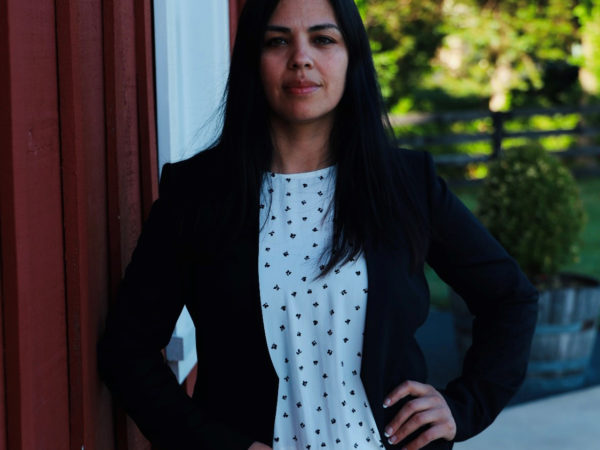Getting to know datacenter employees: Ana Brasil
Microsoft’s success depends on our people. We are proud to introduce some of the talented folks in your community who work in our global datacenters. Discover what inspired them to pursue a career in the tech industry, the different pathways they pursued, and what a day in the life of a datacenter employee looks like.
Introducing Ana Brasil
Datacenter Project Manager
Northern Virginia
Employee since 2017
Early days
Ana spent her early days in a world far away from servers and computers. She grew up on her grandparents’ farm in Brazil and helped them cultivate the land, raise animals, and farm bees. “I didn’t have my first computer until I went to middle school. But I don’t feel like I missed anything. There are so many other things I was able to experience.” Ana played outside with her cousins and brothers—games like “king of the hill,” each kid trying their best to stay on top of a big pile of chaff from harvested grains. The kids biked, ran horses, and took care of chores like getting water. At night, they gathered around to listen to their grandfather play accordion and sing, while uncles played the guitar. The older generation told stories about how they grew up. The house was full of life. Besides family, neighbors gathered; in some cases, they sought herbal cures from Ana’s grandmother, a native Brazilian, who possessed vast knowledge of plant remedies for ailments like earache, indigestion, miscarriage. To this day, Ana loves spending time outside and listening to music.
The path to technology
As a teen, Ana moved to the city and traded farm life for school life. Her first love was reading poetry, influenced by a Portuguese literature teacher. The head of the technology program encouraged her to learn about computers. She took classes in information technology and completed a certificate in information technology alongside her high school curriculum.
Several years later, Ana moved to Chicago and attended a community college program fair, where she met a teacher who encouraged her to apply for the computer repair program. She hesitated—she was the only woman and the only parent there—but forged ahead and completed a computer repair and maintenance certificate. In fact, Ana earned the highest grade in the class, which qualified her for a paid technology certification and job placement assistance. She launched her career as an IT administration consultant for IBM. Here she found a mentor in her manager, who told her, “You should do this for a living. You’re really good at it, good with people.” She taught Ana to do tasks outside the scope of her job and at the end of the project, helped her find a job in desktop support with global consulting company.
Relocating from Chicago to North Carolina, Ana transitioned from desktop to datacenter support, which involved retraining for a hardware-focused role. Ana’s employer paid for her to complete two certifications, Server+ and Network+. A year and a half later, Ana joined Microsoft as a full-time senior datacenter technician, working escalations and harder tickets. Since then, she has risen into a technical trainer role and most recently the datacenter project manager position she holds now.
Superpowers
Ana came into a project manager role from a technical background. This experience armed her with an understanding of what it takes to bring people together and get things done right. “Sometimes it’s easy to sit in your office and say, ‘We need to get this done.’ But you forget how much effort it takes to get things done.” To this end, her superpowers are empathy and attention to detail. Empathy helps Ana connect with people around her and understand what they are going through so they can work effectively together. An understanding of technical details empowers her to identify gaps. “I am very picky,” she says. “You pick up a lot of things that might look like they don’t matter, but in the long run it’s the details that matter. That’s what makes the difference in a successful deployment.” These two superpowers help Ana coordinate people working together on complicated projects. “The most important thing in this work I’ve learned is being able to have so many people, different backgrounds, different cultural values get together, and all deliver something. It is a big project involving a lot of people responsible for different things, so we make sure to ease the transactions among them, so the gaps get filled.”
“The most important thing in this work I’ve learned is being able to have so many people, different backgrounds, different cultural values get together, and all deliver something. It is a big project involving a lot of people responsible for different things, so we make sure to ease the transactions among them and make sure the gaps get filled.”—Ana Brasil
A day in the life
Ana begins her day with a status check on current projects—she checks her emails and calendar and walks onto the datacenter floor for a progress update on what has been completed and what is still pending. Ana oversees a team of vendors, so part of her job is to check the quality of their work, track whether they are meeting the expected timeline, and make sure they have the materials they need to complete the work. Finally, she updates everyone on her team on the status of their projects.
A highlight of the workday for Ana is helping bring so many people and technical systems together into a functioning system. “The part I enjoy most is just going out to the floor and actually being able to see that what was an empty building is now full of racks and lights. You get a sense of accomplishment. You can say, ‘Hey, we put this together and it looks great.’ All the cabling looks neat, everything looks pretty. You can see the fruit of your work. You can see all the meetings, all the Excel spreadsheets you updated, all your scheduling and talking to people—all the coordination coming together and functioning together.”
Favorite childhood food
Ana’s favorite childhood food? “Feijoada,” she answers without hesitation. Feijoada is not only a delicious comfort food, but also a triumph of culinary ingenuity. The dish originates in the era of slavery in Brazil, Ana explains. Slaves were given the castoff pieces of pork, pieces like joints and ears that otherwise would not be used; they cured this meat and then stewed it with other leftover scraps of root vegetables, beans, tomatoes, and spices to create a nutritious meal—Brazil’s signature dish.



